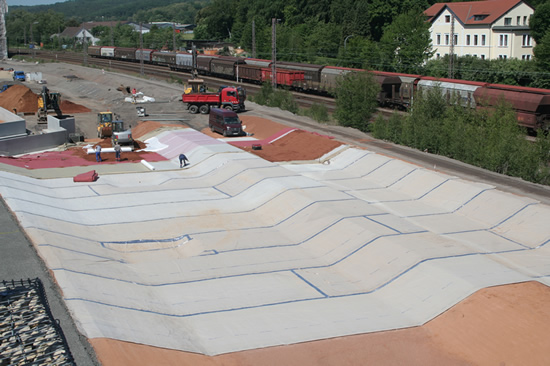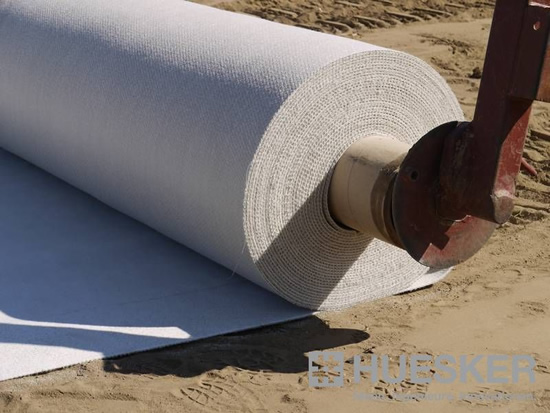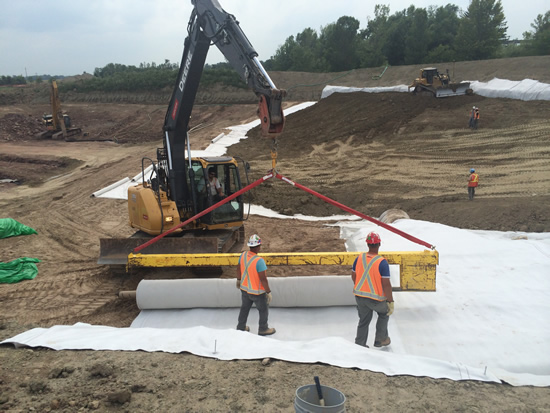



The use of geosynthetic clay liners–GCLs–in engineered barrier systems has broadened substantially. Part of this growth has been fueled by a long record of successful performance. And, as with other geosynthetics, the growth has also been supported by numerous manufacturing and design advances. These have enabled GCLs to be far more application and site-specific today.
GCLS & BENTONITE
Foremost, GCLs have excelled because of what makes up their core: bentonite.
Geosynthetic clay liners are composite materials. No matter how the outer layers are constructed, the core of a GCL will be made of bentonite, which offers the highest swelling characteristics of natural materials. Bentonite’s strong montmorillonite content enables it to increase its volume considerably in contact with water.
Varying grades of bentonite are used for a diverse range of industries and applications, such as drilling operations, slurry walls, clarifying wine and spirits, and the production of clumping cat litter.
The bentonite used in GCLs is of a high quality and offers a number of functional advantages in containment systems:
- The high-swelling nature of the bentonite creates an immediate seal around a puncture.
- A single truckload of GCL panels can provide containment equivalent to 140+ truckloads of compacted clay. This delivers cost, sustainability, and design advantages.
- The overall sealing system can be thinner when GCLs are incorporated (vs. clay-only systems). This makes construction quicker and more economical. It can also make sites more efficient, or even enable more revenue, depending on the type of containment operation. That is, a thinner base sealing system (or thinner cap, in which GCLs are also used) can mean more air space for containment without sacrificing any factor of safety.
- Compacted clay liners are subject to long-term desiccation and cracking. GCLs, with their geosynthetic cover/carrier layers and special modifications, offer defenses against desiccation and cracking.
Manufacturing advances to the external structure of a GCL have been a major part of the material sector’s expanding role in engineering, but modification of bentonite is also occurring and providing some very interesting utility.
CETCO, which pioneered its successful GCL lines more than 25 years ago, has in the past few years released polymer-enhanced GCLs into the market. The Continuum line uses Bentonite Polymer Alloy, which is a polymer synthesized in the bentonite. It heightens the product’s chemical resistance for use in the containment of very aggressive leachates (e.g., FDG coal ash). The polymer size can be adjusted for the application and the material is available in standard GCL options (e.g., reinforced nonwoven/nonwoven) such as found on the classic Bentomat line.
The company’s Resistex™ GCLs also use polymer enhancement to enable greater chemical resistance. And the InterLoK series of geosynthetic clay liners use non-biodegradable, high-viscosity polymers to offer significantly lower permeability.
LONG-TERM PERFORMANCE & EFFICIENCY
While GCLs begin with the bentonite, their long-term performance and efficiency relies heavily upon the geosynthetic components. It is here that we find the secure containment for the bentonite so that it can perform its sealing function. The geosynthetic components are also where we find frictional characteristics to enable installation on steeper slopes, scrim-reinforcement for stronger panels, treated geotextiles for added protection and durability, and much more.
As noted, polymeric enhancement has been used with bentonite in some products, but this is also happening with the outer geosynthetic components. Various companies are now offering this polymer modification for application-improving results.
The Bentofix® GCL line from NAUE is well-established globally, and the company even received an IGS Award from the International Geosynthetics Society (IGS) for its invention of the nonwoven geotextile needlepunching process that greatly enhanced the frictional characteristics of GCLs. That invention enabled GCLs to branch out into more diverse installation configurations, such as steeper slopes.
Today, the company also has made headway in polymer-enhancement of the outer geotextile. The Bentofix® X line has a spray-applied polymeric coating to a woven geotextile component. Installed facing up, it enhances root protection, guards against desiccation, and provides stronger gas barrier performance (in addition to its liquid barrier strength).
An example of its resilience can be found in Miyagi Prefecture in Japan. There, an agricultural pond with a depth of 7m and with 1:2 slopes had been lined with a Bentofix® X product. When the Miyagi Earthquake struck in 2012, the banks of the pond were severely damaged. The Miyagi earthquake was the 5th most powerful modern earthquake and caused a meltdown at the Fukushima nuclear plant. Infrastructure throughout Miyagi prefecture suffered. What’s interesting about the pond is that though its banks failed to the degree the owner opted to rebuild it, the GCL panels were still intact. They had tolerated the settlement and continued to perform as designed. The owner subsequently reordered the same GCL to line the refurbished pond.
Another robust product that characterizes the advantages in GCL modifications is HUESKER‘s Tektoseal®. It utilizes a high-tensile base and a durable nonwoven geotextile to improve the internal angle of friction, increase shear strength, and offer better outer frictional properties. This leads to greater applicability for steep slopes.
In Germany, this GCL is being used for an important reservoir project (construction to be completed in November 2014).
Also, GCLs are sealed on one side with geomembranes in some cases. GSE Environmental, which is generally recognized for its HDPE geomembranes, has a very successful series of LLDPE and HDPE-supported GCLs (GSE GundSeal).
BRANCHING OUT
The greater frictional characteristics of GCLs are seeing them designed much more often into steep-sloped installations, including large-scale heap leach operations (though not as a primary liner). It was recently revealed that up to 40% of the world’s annual geomembrane production is being used in the mining industry, particularly with heap leach operations expanding, but that also means designers are using other geosynthetics along with geomembranes in mining.
GCLs, designed into heap leach systems with geocomposites and geotextiles, are providing excellent support for the primary geomembrane liners used on the slopes at these ever-escalating facilities. Ore heaps are exceeding 100m! Proper containment on slopes and in liquor trenches and processing pits is making heap leaching more efficient and profitable. It also provides a great deal of environmental protection.
Agru America, which is been generally known for its geomembranes, is also very active in the GCL market now with its GeoClay™ series. They manufacture a full line of GCL products with variable bentonite loading and textile types. The GCL can be lightly reinforced for flat areas or may exhibit high peel strength as needed to meet site specific conditions for high pressure and/or steeper slope applications. The company’s primary focus for this product line is the landfill and mining industry. In addition to landfill type GCL products, they publish data sheets for GeoClay products specifically for mining applications.
This is just one of the many areas into which GCLs are being designed increasingly, thanks to manufacturing advances that have further improved durability, longevity, and bentonite performance.
IMPORTANCE OF EXPERTISE
While the installation guidelines for GCLs are pretty clear, installation expertise is advised for sensitive and sizable installations. While GCLs do not need to be welded in the field like HDPE geomembranes, one must be careful with panel overlaps, pre-hydration, addition of bentonite or special seals at the overlaps, incorporation of appurtenances or penetrations, etc.
The International Association of Geosynthetic Installers (IAGI) publishes a membership list on its website. You can search for companies and gather contact information. You can also see IAGI’s list of Approved Installation Contractors (AIC), which is a special designation granted companies that meet specific AIC program bars for professionalism and company strength.
Examples of IAGI members and AIC designation holders are Colorado Lining International and Titan Environmental Containment. These companies are involved in a diverse range of projects, operate internationally, and have long worked with GCLs in waste management, secondary containment, mining, energy, and elsewhere.
Also, do not forget the importance of construction quality assurance (CQA). CQA Solutions Ltd.‘s Glen Toepfer has advocated for the “zero-leak” approach to lining systems. It’s an ambitious goal, but one he has achieved on a spectacular level with the Palo Verde Nuclear Generating Station in containment system in Arizona. That leak-free installation is now in its seventh year. Toepfer emphasizes strong communication, expert installation, and dedicated CQA. Expertise = significantly lower risk. “It saves money,” he says.
In the years since the Palo Verde work was performed, CQA Solutions also developed a multi-tiered certification platform, which is being opened to the greater engineering field in February 2016. The program has grown out of the company’s in-house quality system and will now be shared with the profession.
ON THE WEB
Manufacturers, installers, and other stakeholders in the geosynthetics field regularly publish detailed project references, GCL data, design-related brochures, etc. Social media (Facebook, Twitter, LinkedIn, Google+) is also becoming a strong tool for getting almost real-time project updates from around the world.
Terrafix, for example, maintains a very active and photo-rich social media presence. Follow Terrafix Geosynthetics on Facebook or link through from the company’s website.
Geofabrics Australasia is another company doing a great deal with social media: project photos, technical article links, and more.











